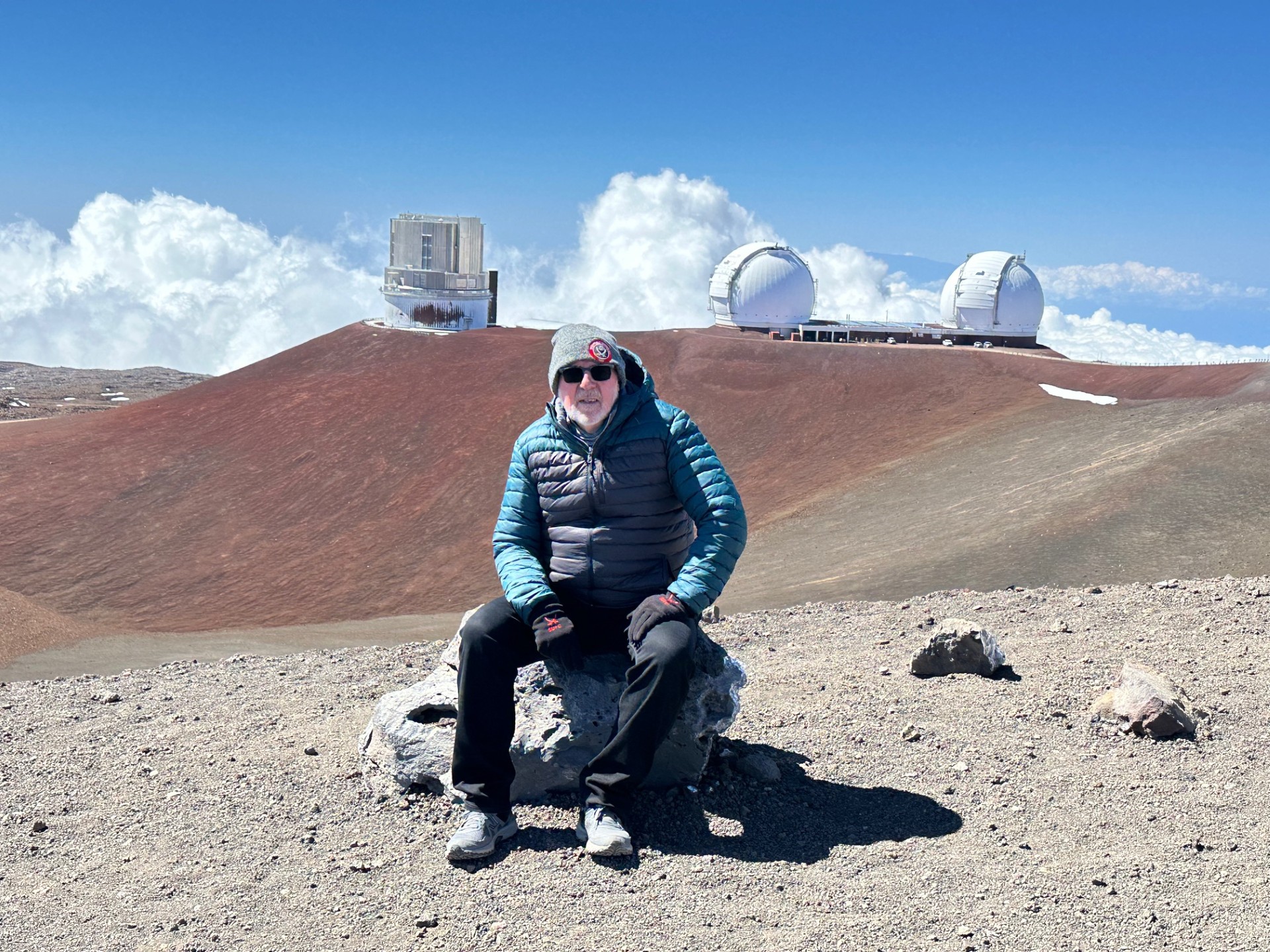Mauna Kea
Aloha!
A few weeks ago I was lucky enough to visit Big Island, Hawai’i.
Whilst there we drove to the summit of Mauna Kea,
It was a memorable experience.
The mountain is home to the largest collection of major telescopes in the world.

Mauna Kea is a dormant shield volcano which straddles Big Island.
It is the highest mountain in the world!
Well, sort of.

Mauna Kea by moonlight. Credit: International Gemini Observatory/NOIRLab/NSF/AURA/J. Chu
Mount Everest measures 29,032 feet from sea level to summit.
Mauna Kea is 13,800 feet above sea level.
But from its base at the bottom of the Pacific Ocean, it measures 30,610 feet.
So in those terms, Mauna Kea is the tallest peak of all.
Mauna Kea observatories
There are twelve observatories spread around the summit.
It’s the highest concentration of large professional telescopes on Earth.
Most are American-run but many other countries are represented here.
They make Mauna Kea one of the premier astronomical locations in the world.

My Visit
Approach
We set off from Wailkoloa Village at sea level.
The Saddle road crosses the island.
Half way along the saddle is the turn to Mauna Kea.
We began the gentle ascent to the Visitor Centre.
This is part of the Onizuka Centre for international Astronomy.
This mid-level complex is at 9,600 feet.
Onizuka Centre
The Centre is named for Ellison Onizuka.
He was the first ever Hawaiin astronaut.
Sadly he died in the Challenger Space Shuttle tragedy in 1986.

Visitor Centre, Photo: Dennis Ashton
The centre has housing for up to 72 visiting astronomers and technicians.
There are also cabins for maintenance workers.
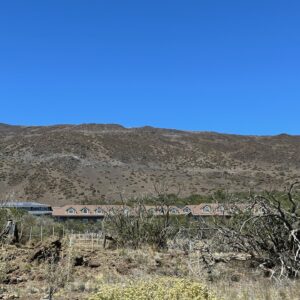
Astronomers housing. Photo: Dennis Ashton
The gift shop sells branded clothing and souvenirs but no food.
If you go to Mauna Kea, take a picnic and drinks.
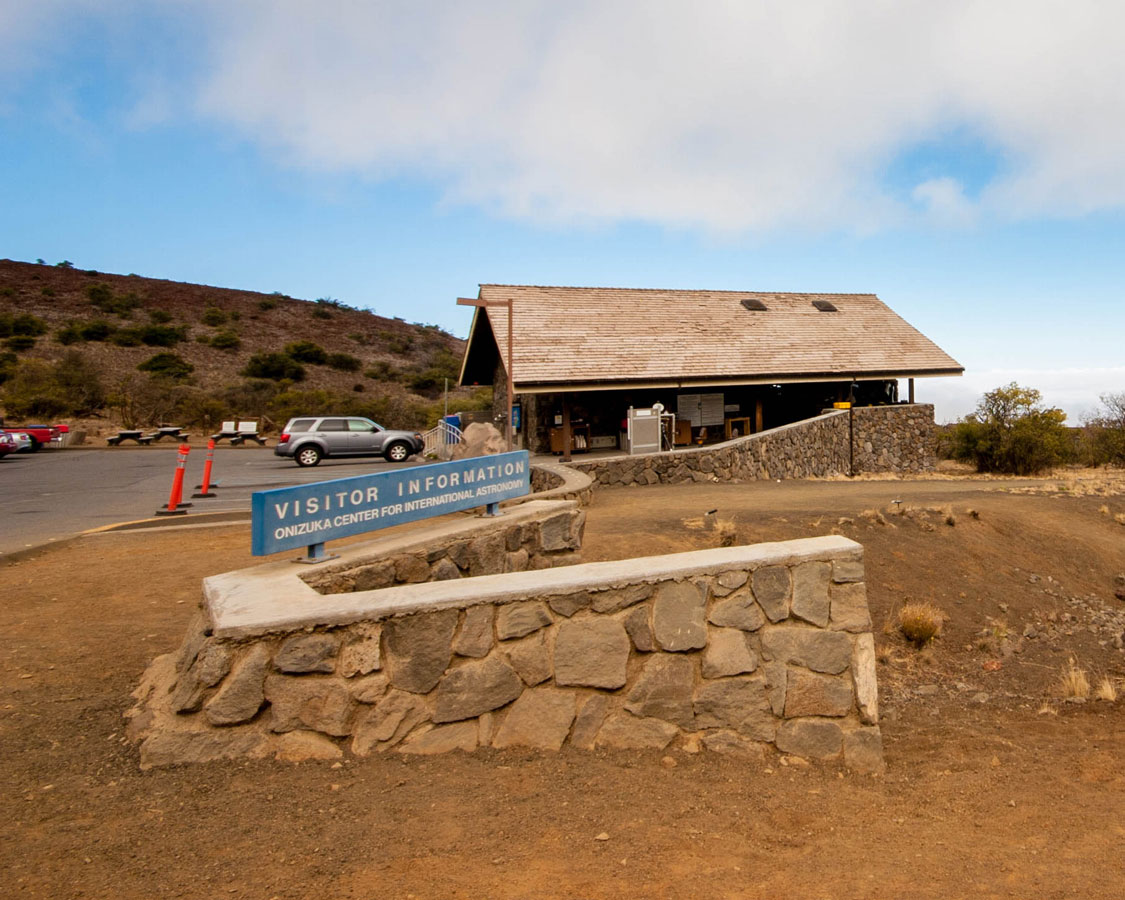
The visitor centre runs stargazing nights with astronomer guides and telescopes.
Private tour companies also run regular observinbg sessions for their customers.
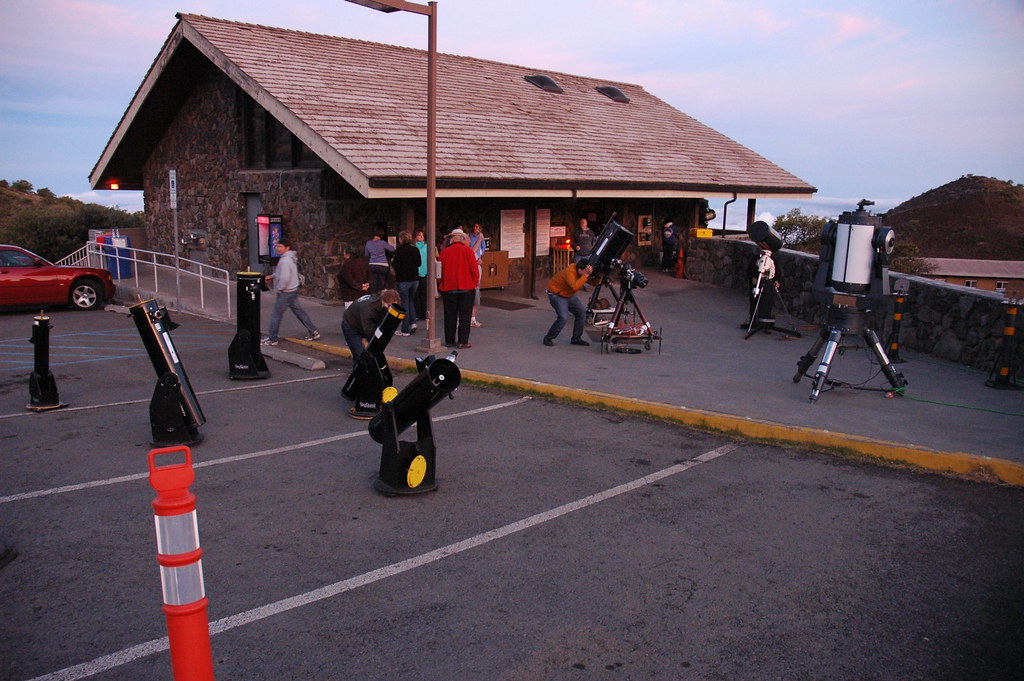
Summit Drive
There is an 8-mile drive from the visitor centre to the summit.
Most of it is a rough dirt road, not for the faint-hearted.
Only 4 wheel drive vehicles are allowed on the summit road.
We had a Jeep Wrangler, ideal for the job.
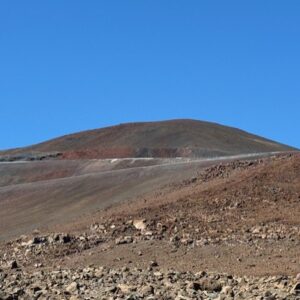
Summit road. Photo: Dennis Ashton
We spent around an hour at the visitor centre to have lunch and acclimatise to the altitude.
Rangers were on hand to check our vehicle and give driving advice.
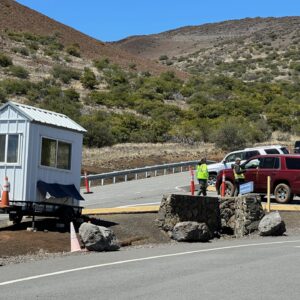
Vehicle checkpoint. Photo: Dennis Ashton
The ranger taught us how to use the special low gear function on our descent.
This prevents the brakes from over-heating.
After a short paved section, we hit the dirt road.
It is bumpy and potentially dangerous.
We were thrown about in the Wrangler, even at low speed.
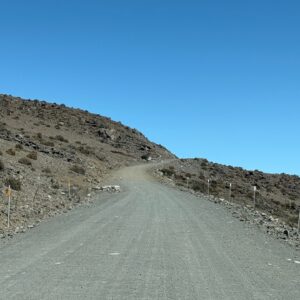
Summit dirt road. Photo: Dennis Ashton
We eventually rounded a bend and saw the summit.
There the road is paved again to reduce dust swirling around the observatories.
Driving on to the top is like entering a Martian landscape.
Red volcanic soil spreads over the cinder cones. Nothing grows.
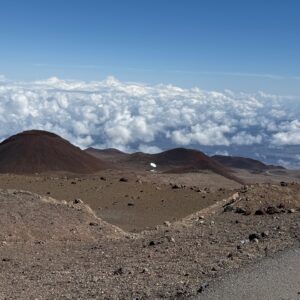
Summit scene. Photo: Dennis Ashton
At the Summit
At the top of Mauna Kea, three things become immediately apparent.
Firstly, it’s cold.
Down by the ocean the temperature is a tropical 28C.
At Mauna Kea summit it’s zero degrees, literally freezing.
Snowfields still remain at the top, like icing on a cake.
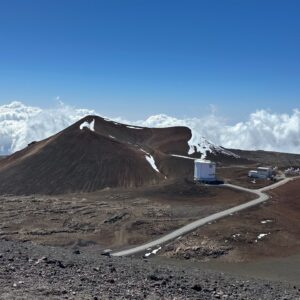
Mauna Kea summit with the James Clerk Maxwell observatory.
Then you feel the effects of altitude.
At sea level, our air is around 21% oxygen.
At almost 14,000 feet, oxygen levels drop to a mere 12%.
And it shows.
Walking around, particularly uphill, makes you quite breathless.

Summit of Mauna Kea
The third impression is the clarity of the air.
Looking around, it’s like seeing in high-definition.
We looked towards one of the summit ridges.
The observatories stood out in ultra-clear vision.
Beyond them we saw cloud tops.

Subaru and Keck observatories
This is why Mauna Kea is a prime astronomy site.
At this altitude we’re above the clouds, the sky is clear.
We’re also above much of Earth’s atmosphere.
So stars and galaxies are not so distorted by our air.
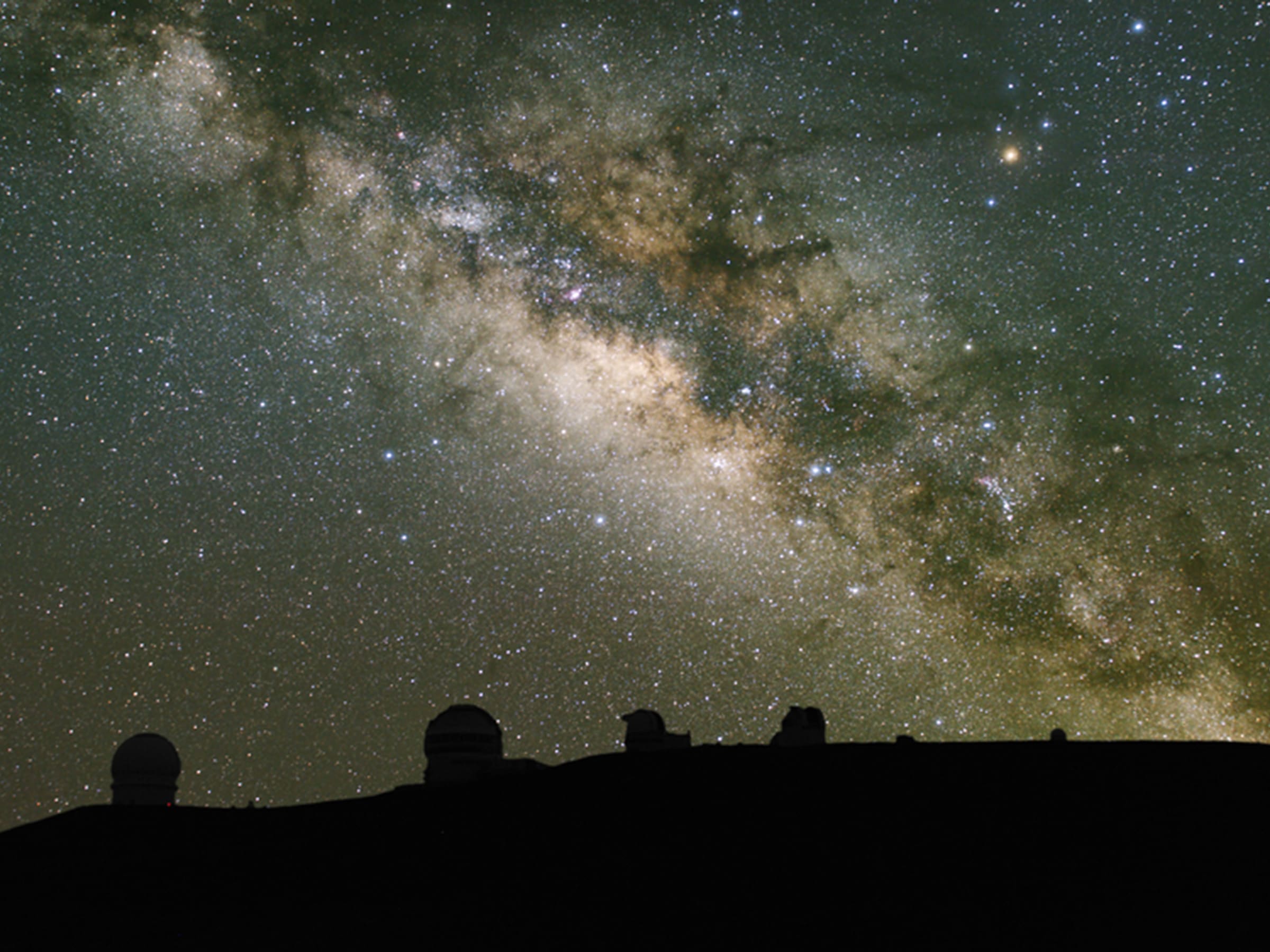
And, of course, there is no light pollution.
Big Island has sky-friendly public lighting in the towns.
The Mauna Kea night sky is about as perfect as it can be.
The Observatories
We strolled around the summit and the observatories.
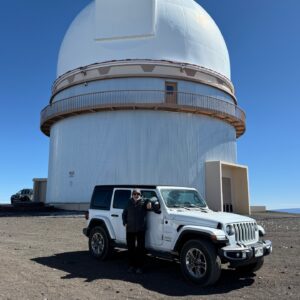
University of Hawaii observatory
They represent some of the most important astronomical research stations.
Major discoveries have been made here.
I’ll explore some of them in my next blog.
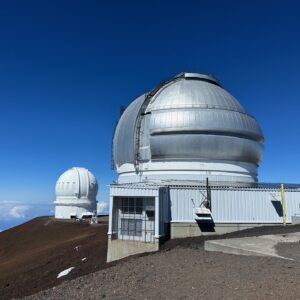
Gemini North Observatory. Photo: Dennis Ashton
Return journey
The observatories attract visitors from all over the world.
At the summit, we met Shannon and Lee from Canada.
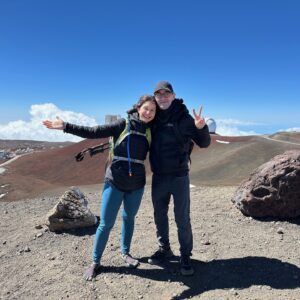
Their car was not a 4-wheel drive and wasn’t allowed on the summit road.
So they hiked some 4,000 feet to the top.
That’s a challenge at this altitude.
Needless to say, we gave them a lift back to the visitor centre.
If you read this blog, Shannon and Lee, our best wishes from the UK.
In the special low gear, the ride down the mountain was much more comfortable than our ascent.
Our trusty Wrangler smoothed out the bumps and the road became much less of a challenge.
Back at the visitor centre, a ranger checked our brakes.
They were cool and I received a congratulations for good driving.
Finally, a little Hawaiin.
The Hawai’in language has only 13 letters.
They are the 5 vowels – A, E, I, O, U – and 8 consonants – H, K, L, M, N, P, W and ‘ (the okina).
Different combinations of letters give different sounds in pronunciation.
My favourite Hawaiin word is the name for their state fish.
It is the reef triggerfish.
In Hawaiin the triggerfish is the humuhumunukunukuapua’a.
That’s pronounced hoo-moo-hoo-moo-noo-koo-noo-koo-ah-poo-ah-ah.
Have a try at it!
Next time
In my next blog we’ll take a look at some of the great observatories on Mauna Kea.
We’ll also discover that the world’s largest telescope may join them.
Mahalo for reading.
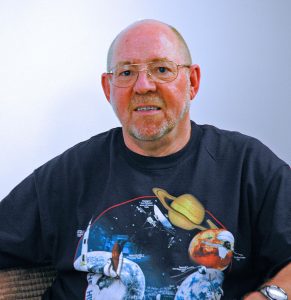
The author: Dennis Ashton is a Fellow of the Royal Astronomical Society and a Wonderdome presenter.
In 2024, Dennis received the Special Contribution award from the British Association of Planetaria.
Wonderdome now has 14 presenters, making us the largest – and best – mobile planetarium organisation in the UK.
Would you like to hear more Astronomy news?
Do you want to to find out about our upcoming public events?
Follow WonderDome Portable Planetarium on Twitter and Facebook or go to our web site wonderdome.co.uk

